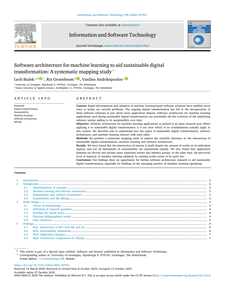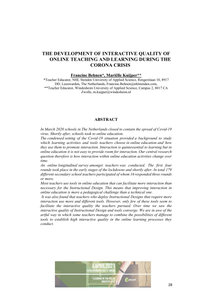Evaluation of the effect of Problem Based Learning course
DOCUMENT

Presented at Conference: IPMA World Conference 2014, At Rotterdam, The Netherlands, Volume: 28 A taxonomy is used for classifying things in general. For the purpose of this paper it is a systematic classification of competences into hierarchical groups where each sublevel constitutes a breakdown of the higher level. Although a vast amount of research has been done in project management competences, there is no standard set of project management competences used (Nijhuis, 2012). Important reasons for constructing a taxonomy for project management competences are found in comparing previous research and in identifying key fields for project management education in higher education. First a definition of competence is given, secondly the rationale of this research is given by discussing recent research. Several different published taxonomies of competences are reviewed. Finally a proposed taxonomy for project management competences is presented.
DOCUMENT

Within NHL Stenden University of Applied Science, a choice for a new virtual learning environment was made in mid-2021, primarily on policy and management grounds. Early in the migration process, it became clear that this approach could perturb the further rollout of the Design-Based Education (DBE, https://edu.nl/mwp8j) educational concept. Four templates were developed to intertwine technological and educational processes that structure different ways of "blended" learning and teaching within DBE. Initial user experiences show that the templates’ structures help teachers reconsider online learning activities to shape and facilitate blended DBE learning processes.
DOCUMENT

Context:Rapid developments and adoption of machine learning-based software solutions have enabled novel ways to tackle our societal problems. The ongoing digital transformation has led to the incorporation of these software solutions in just about every application domain. Software architecture for machine learning applications used during sustainable digital transformation can potentially aid the evolution of the underlying software system adding to its sustainability over time.Objective:Software architecture for machine learning applications in general is an open research area. When applying it to sustainable digital transformation it is not clear which of its considerations actually apply in this context. We therefore aim to understand how the topics of sustainable digital transformation, software architecture, and machine learning interact with each other.Methods:We perform a systematic mapping study to explore the scientific literature on the intersection of sustainable digital transformation, machine learning and software architecture.Results:We have found that the intersection of interest is small despite the amount of works on its individual aspects, and not all dimensions of sustainability are represented equally. We also found that application domains are diverse and include many important sectors and industry groups. At the same time, the perceived level of maturity of machine learning adoption by existing works seems to be quite low.Conclusion:Our findings show an opportunity for further software architecture research to aid sustainable digital transformation, especially by building on the emerging practice of machine learning operations.
DOCUMENT

This study furthers game-based learning for circular business model innovation (CBMI), the complex, dynamic process of designing business models according to the circular economy principles. The study explores how game-play in an educational setting affects learning progress on the level of business model elements and from the perspective of six learning categories. We experimented with two student groups using our game education package Re-Organise. All students first studied a reader and a game role description and then filled out a circular business model canvas and a learning reflection. The first group, i.e., the game group, updated the canvas and the reflection in an interactive tutorial after gameplay. The control group submitted their updated canvas and reflection directly after the interactive tutorial without playing the game. The results were analyzed using text-mining and qualitative methods such as word co-occurrence and sentiment polarity. The game group created richer business models (using more waste processing technologies) and reflections with stronger sentiments toward the learning experience. Our detailed study results (i.e., per business model element and learning category) enhance understanding of game-based learning for circular business model innovation while providing directions for improving serious games and accompanying educational packages.
MULTIFILE

In March 2020 schools in The Netherlands closed to contain the spread of Covid-19 virus. Shortly after, schools took to online education. The condensed setting of the Covid-19 situation provided a background to study which learning activities and tools teachers choose in online education and how they use them to promote interaction. Interaction is quintessential to learning but in online education it is not easy to provide room for interaction. Our central research question therefore is how interaction within online education activities change over time. An online longitudinal survey amongst teachers was conducted. The first four rounds took place in the early stages of the lockdowns and shortly after. In total 179 different secondary school teachers participated of whom 16 responded three rounds or more. Most teachers use tools in online education that can facilitate more interaction than necessary for the Instructional Design. This means that improving interaction in online education is more a pedagogical challenge than a technical one. It was also found that teachers who deploy Instructional Designs that require more interaction use more and different tools. However, only few of these tools seem to facilitate the interactive quality the teachers pursued. Over time we saw the interactive quality of Instructional Design and tools converge. We are in awe of the artful way in which some teachers manage to combine the possibilities of different tools to establish high interactive quality in the online learning processes they conduct.
DOCUMENT

Background: While the interest of health promotion researchers in change methods directed at the target population has a long tradition, interest in change methods directed at the environment is still developing. In this survey, the focus is on methods for environmental change; especially about how these are composed of methods for individual change ('Bundling') and how within one environmental level, organizations, methods differ when directed at the management ('At') or applied by the management ('From'). Methods: The first part of this online survey dealt with examining the 'bundling' of individual level methods to methods at the environmental level. The question asked was to what extent the use of an environmental level method would involve the use of certain individual level methods. In the second part of the survey the question was whether there are differences between applying methods directed 'at' an organization (for instance, by a health promoter) versus 'from' within an organization itself. All of the 20 respondents are experts in the field of health promotion. Results: Methods at the individual level are frequently bundled together as part of a method at a higher ecological level. A number of individual level methods are popular as part of most of the environmental level methods, while others are not chosen very often. Interventions directed at environmental agents often have a strong focus on the motivational part of behavior change. There are different approaches targeting a level or being targeted from a level. The health promoter will use combinations of motivation and facilitation. The manager will use individual level change methods focusing on self-efficacy and skills. Respondents think that any method may be used under the right circumstances, although few endorsed coercive methods. Conclusions: Taxonomies of theoretical change methods for environmental change should include combinations of individual level methods that may be bundled and separate suggestions for methods targeting a level or being targeted from a level. Future research needs to cover more methods to rate and to be rated. Qualitative data may explain some of the surprising outcomes, such as the lack of large differences and the avoidance of coercion. Taxonomies should include the theoretical parameters that limit the effectiveness of the method.
DOCUMENT

This chapter discusses educational aspects and possibilities of serious games. For researchers as well as game designers we describe key learning theories to ground their work in theoretical framework. We draw on recent metareviews to offer an exhaustive inventory of known learning and affective outcomes in serious games, and to discuss assessment methods valuable not only for research but also for efficient serious game design. The implementation and design of serious games are outlined in separated sections. Different individual characteristics that seem to be strongly affecting process of learning with serious games (learning style, gender and age) are discussed with emphasis on game development.
MULTIFILE
Motor learning is particularly challenging in neurological rehabilitation: patients who suffer from neurological diseases experience both physical limitations and difficulties of cognition and communication that affect and/or complicate the motor learning process. Therapists (e.g.,, physiotherapists and occupational therapists) who work in neurorehabilitation are therefore continuously searching for the best way to facilitate patients during these intensive learning processes. To support therapists in the application of motor learning, a framework was developed, integrating knowledge from the literature and the opinions and experiences of international experts. This article presents the framework, illustrated by cases from daily practice. The framework may assist therapists working in neurorehabilitation in making choices, implementing motor learning in routine practice, and supporting communication of knowledge and experiences about motor learning with colleagues and students. The article discusses the framework and offers suggestions and conditions given for its use in daily practice.
DOCUMENT

An important step in the design of an effective educational game is the formulation of the to-be-achieved learning goals. The learning goals help shape the content and the flow of the entire game, i.e. they provide the basis for choosing the game’s core (learning) mechanics. A mistake in the formulation of the learning goals or the resulting choice in game mechanics can have large consequences, as the game may not lead to the intended effects. At the moment, there are many different methods for determining the learning goals; they may be derived by a domain expert, based on large collections of real-life data, or, alternatively, not be based on anything in particular. Methods for determining the right game mechanics range from rigid taxonomies, loose brainstorming sessions, to, again, not any method in particular. We believe that for the field of educational game design to mature, there is a need for a more uniform approach to establishing the learning goals and translating them into relevant and effective game activities. This paper explores two existing, non-game design specific, methods to help determine learning goals and the subsequent core mechanics: the first is through a Cognitive Task Analysis (CTA), which can be used to analyse and formalize the problem and the knowledge, skills, attitudes that it is comprised of, and the second is through the Four Components Instructional Design (4C-ID), which can be used to determine how the task should be integrated into an educational learning environment. Our goal is to see whether these two methods provide the uniform approach we need. This paper gives an overview of our experiences with these methods and provides guidelines for other researchers on how these methods could be used in the educational game design process.
DOCUMENT
